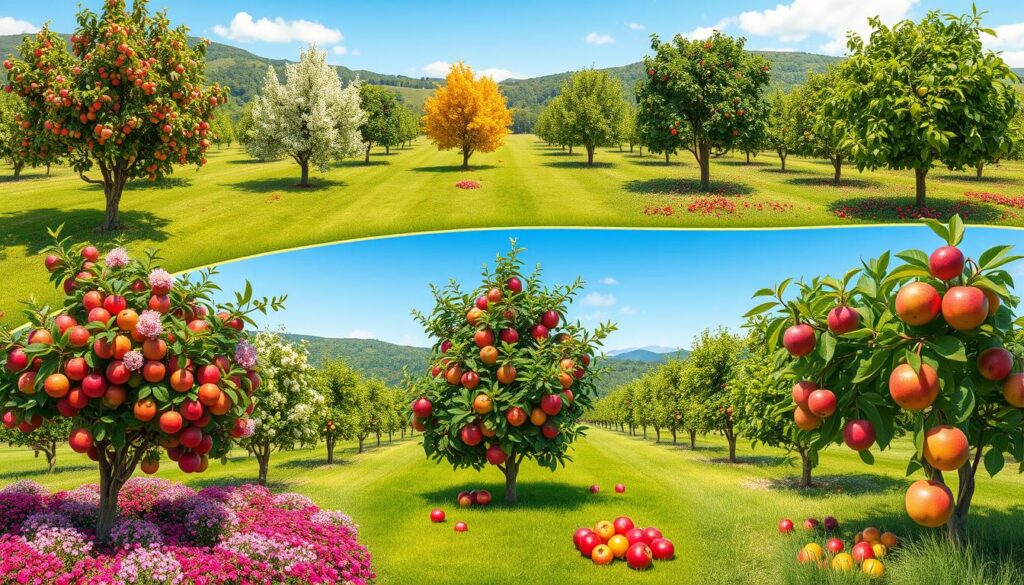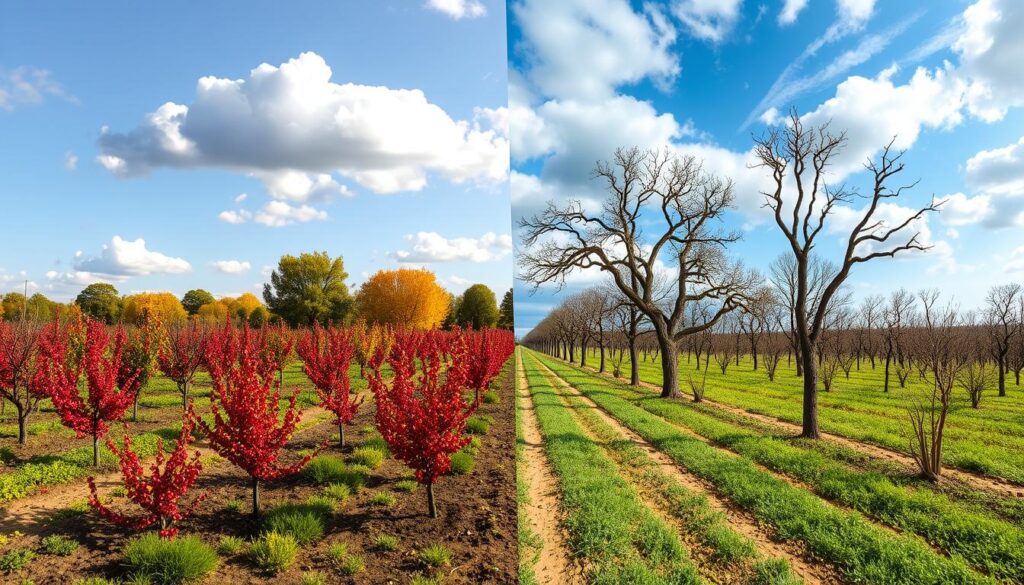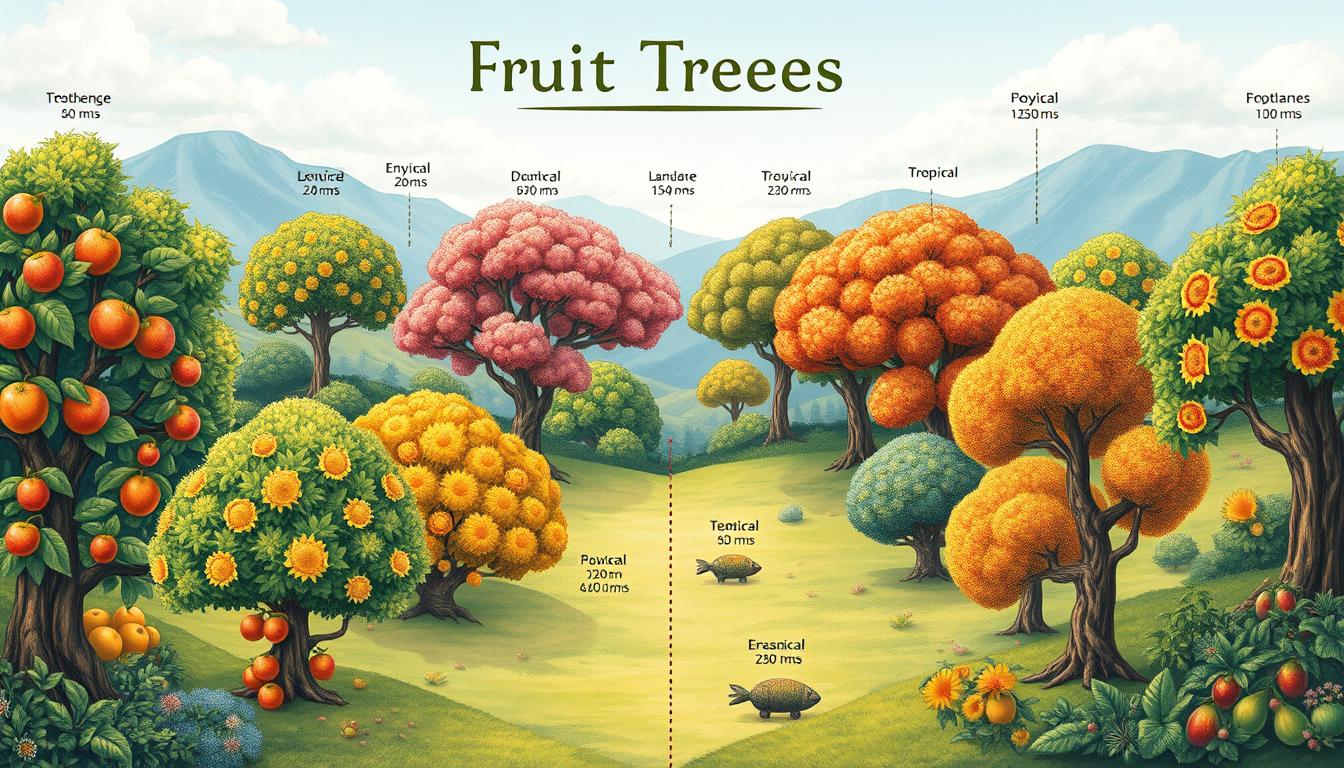When I look into the best time to plant fruit trees in different zones, I see how important it is to know about USDA hardiness zones. Each zone has its own weather that affects which fruit trees grow well and when they should be planted. With a fruit tree planting guide, I know planting fruit trees is a big deal. It’s a long-term investment that can bring lots of fruit for years.
By picking the right time and method for my zone, I help my fruit trees grow strong. This means they will produce fruit well in the future.
Key Takeaways
- Understanding your USDA hardiness zone is crucial for successful fruit tree planting.
- Choosing the right timing maximizes growth potential and fruit production.
- Bareroot trees are generally more affordable and offer a wider variety than container-grown trees.
- Fruit trees in zones 7 and below should be planted in early spring while dormant.
- Maintaining proper planting depth is vital for the survival of bare root trees.
The Importance of Understanding Your Planting Zone
Knowing your USDA Hardiness Zones is key to gardening success. These zones are based on the lowest average temperatures. They help you choose the right plants, like fruit trees, for your area. This knowledge is crucial for picking trees that will grow well, not just survive.
What Are USDA Hardiness Zones?
The USDA Hardiness Zones go from 1a to 13b. Lower numbers mean colder winters. Zones 5, 6, and 7 are great for many fruit trees, as Cummins Nursery points out. It’s vital to pick trees that fit your zone for a good harvest. The USDA has a tool to help find the right trees for your zip code.
Why Zone Understanding Affects Tree Selection
Choosing fruit trees without knowing your zone can be a letdown. Different trees need specific cold hours to bear fruit. For example, zones 3-6 are better for some trees than warmer places like Florida. By using websites with detailed product info, you can find the best trees for your area. Knowing your native growing conditions helps your garden thrive.
In short, understanding USDA Hardiness Zones helps you pick the right trees. This leads to a more successful garden. By matching your selections to your region’s needs, you can keep your garden healthy. For more tips and guides, check out GardenBeginner.com.
Choosing the Right Fruit Trees for Your Zone
Choosing the right fruit trees is key for a good harvest. Climate, hardiness zones, and tree needs are important. Knowing if you need self-pollinating trees or ones that need a pollinator is crucial. In USDA zones 9b-10a, some trees do well, while others don’t.
So, it’s vital to research well.
Self-Pollinating vs. Pollinator-Requiring Trees
Self-pollinating trees, like nectarines and figs, are easy because they don’t need another tree. They’re great for small gardens or city spaces. On the other hand, trees like apples and pears need a partner tree for pollination.
When picking, I think about how much space I have and how many trees I can fit.
Researching Tree Varieties Suitable for Each Zone
It’s important to find trees that will grow well in your zone. I check how many chill hours each tree needs. Trees like persimmons and pomegranates do well in warm places.
But, some trees need over 300 chill hours, which is better for cooler areas. I use local resources to find the best trees for my zone.
Before deciding, I check local hardiness zones by entering my zip code. This helps me pick the right trees for my area. It also helps me get better fruit. For more tips, I visit this site to learn about tree selection and care.
The Best Time to Plant Fruit Trees in Different Zones
Knowing when to plant fruit trees is key for a good harvest. The right time changes with the climate and hardiness zones. I need to consider my local climate, like frost dates and rainfall, to help my trees grow.
Timing Based on Climatic Conditions
The weather tells me when to plant fruit trees. In cold zones, I wait until early spring when the ground is thawed. Warmer areas let me plant later in spring or even in summer. Knowing how much chill time each fruit needs is important. Some fruits need the right cold periods to bloom well.
Zone-Specific Planting Recommendations
It’s vital to follow planting advice for each zone. For example, I’ve learned these tips:
| Zone | Best Planting Time | Recommended Varieties |
|---|---|---|
| 3-4 | Late spring | Cold-hardy apples, cherries |
| 5-6 | Early spring or late fall | Peaches, nectarines |
| 7 | Spring or early fall | Figs, plums |
| 8+ | Late fall or early winter | Citrus, avocados |
With the right planning and knowledge of my zone, I can pick the best time to plant. This ensures my trees grow well and give me plenty of fruit over time.

Optimal Planting Season for Fruit Trees
Figuring out the best time to plant fruit trees is key. It’s about setting their roots right and getting ready for the seasons. Spring and fall have their own pluses and minuses, especially when it comes to planting.
Spring planting lets trees grow all year, getting strong in their new home. But, fall planting can be tough, especially in cold areas.
Spring vs. Fall Planting
Spring or fall, each has its own benefits and drawbacks. Spring gives trees a full growing season, helping them grow strong. Fall, on the other hand, can be harsh, especially for young trees.
- Spring is best for full sunlight and warm soil.
- Fall can be tough for trees without a strong root system.
- Late fall is okay for hardy trees in warm areas but risky for tender ones.
Container-Grown vs. Bare Root Trees
Knowing the difference between container-grown and bare root trees is crucial. Container-grown trees can be planted year-round, like in late spring and summer. They’re more likely to survive transplant shock.
Bare root trees need to be planted in early spring. They’re cheaper and offer more variety but need careful handling.
| Characteristic | Container-Grown Trees | Bare Root Trees |
|---|---|---|
| Planting Season | Late spring, summer, early fall | Early spring only |
| Root System | Established roots | Less developed, dormant |
| Cost | Higher | Lower |
| Transplant Shock | Less likely | More likely |
In conclusion, picking the right planting season and tree type is important. For more tips on planting fruit trees, check out the contact page for helpful resources.
Staggering Your Harvest Times
Harvesting fruit trees well means planning and picking the right trees for different times. This way, I don’t get overwhelmed by too much fruit at once. It makes the harvest season easier to handle.
Choosing Varieties for Different Ripening Times
I focus on picking fruit trees that ripen at different times. For apples, I choose early, mid, and late varieties. This not only stretches my harvest but also makes caring for each tree easier. A harvest chart helps me keep track of when to pick and organize my work.
Managing Large Harvests
When harvests are big, managing them is key to not wasting any fruit. Semi-dwarf trees, for example, give more fruit than dwarf trees. They need enough space for easy picking and processing. A well-planned orchard keeps my workflow smooth, from picking to selling or preserving.
| Tree Type | Height at Maturity | Years to First Fruit | Estimated Lifespan |
|---|---|---|---|
| Dwarf | 8-10 feet | 2 years | 15-25 years |
| Semi-Dwarf | 12-15 feet | 3-4 years | 15-30 years |
| Standard | 25+ feet | 4-6 years | 50+ years |
In summary, knowing how to stagger harvest times and picking the right trees is crucial for a successful fruit garden. With careful planning and the right choices, I get high-quality fruit in good amounts.
Preparing Your Space for Fruit Trees
Getting your planting area ready is key for fruit tree success. I focus on creating the best environment by considering sunlight, soil, and spacing. This ensures my trees grow well and produce great fruit.
Sunlight and Soil Requirements
Fruit trees love full sunlight, needing at least six hours a day. This light is crucial for quality fruit and high yields. The soil must be nutrient-rich and drain well, with compost to boost fertility.
Soil testing a year ahead helps me make any needed changes. This way, the soil is perfect for my trees.
Spacing and Arrangement Considerations
When preparing space for fruit trees, spacing is vital. Too close and trees compete for resources, get less air, and are more prone to disease. Stone fruit trees need 12 to 20 feet apart for growth.
This spacing helps with production and keeps each tree healthy. I also keep weed-free zones around trees to stop weeds from stealing water and nutrients.
For more tips, check out this resource on preparing space for fruit trees.
Steps to Plant Your Bare Root Fruit Trees
Planting bare root fruit trees needs careful planning and the right steps. I use the best tools and practices to help my trees grow well in their new home.
Essential Tools and Materials
Having the right tools makes planting easier. Here are the key tools you’ll need:
- Shovel: For digging the planting hole.
- Compost: To enrich the soil during planting.
- Stakes: To support taller trees in windy conditions.
- Protective tubes: To guard young trees against pests and sun exposure.
- Watering can or hose: For thorough watering post-planting.
Best Practices for Planting
Following the best planting practices is crucial for success. Here are the main steps:
- Prepare the planting hole: The hole should be as deep as the longest root. Make sure the tree’s crown is above the soil.
- Inspect the roots: Cut any broken, rotted, or twisted roots to help the tree grow well.
- Position the tree: Place the tree so its roots can spread naturally. Avoid bending or crowding the roots.
- Add compost: Mix compost with the soil to improve nutrient availability and promote healthy root development.
- Fill in soil: Firmly pack the soil around the roots to eliminate air pockets and ensure good contact.
- Water thoroughly: Water two times during planting, deeply soaking the ground to help settle the soil and provide moisture.
- Mulch appropriately: Spread 3 inches of wood chips or straw around the base to insulate roots but keep it away from the trunk.
- Stake if needed: For trees over 3 feet tall or in windy areas, stake them to protect against damage while roots establish.
By following these steps and using the right tools, my bare root fruit trees have a strong chance of thriving. Each practice helps create a healthy foundation for future growth.
Common Fruit Tree Planting Tips
After planting, it’s key to care for my fruit trees right. I use methods like checking water and mulching to help them grow. These steps are crucial for my trees to thrive.
Watering and Maintenance After Planting
Watering is a big deal after planting. I give 2-5 gallons of water right away to keep the roots moist. It’s important to keep watering, especially when it’s dry.
Mulching with manure or compost helps keep the soil moist. This is a great way to help my trees grow strong.
How to Avoid Transplant Shock
To prevent transplant shock, I make sure to plant at the right depth. This supports the roots well. I also use mulch to keep the soil moist and warm.
Pruning the tree to 30 to 36 inches helps it grow new roots and branches. This makes it recover faster from being transplanted. By following these tips, I can grow healthy fruit trees.
Climate Change and Its Impact on Planting Timing
Climate change has made planting fruit trees harder, changing how we farm. It brings unpredictable weather, so we must adjust planting times for the best fruit. Knowing the microclimates in my area helps me plan better, keeping my fruit trees healthy.
Understanding Microclimates in Your Area
Microclimates are small weather areas that differ from the big picture. They can be affected by hills, water, or cities. By understanding these, I can see how climate change affects my planting spot. For example, areas with early springs mean I can plant sooner, avoiding frost damage.
Adjusting Planting Dates Based on Local Conditions
Adjusting planting times is key, and watching local temperatures is important. Warmer winters can make stone fruits bloom too early, making them vulnerable to cold. I must watch for frost warnings and change my planting plans. Using row covers or water to protect trees from extreme weather is also helpful. This way, I can still grow great fruit, even with climate change.

Conclusion
Knowing when to plant fruit trees is key to their success. The summary of planting times and zones shows how important it is to know your zone. It also helps to pick the right fruit varieties and adapt to the weather.
When planning my orchard, I must think about pollination, upkeep, and watering. For example, placing trees that need pollen close together helps pollination. Also, planting in the right season, like spring or fall, is crucial. This knowledge helps my trees grow well and gives me a great harvest.
By following these tips, I can make a fruitful and lasting orchard. For more on keeping your garden safe and understanding data protection, check out this privacy policy. With the right approach and flexibility, growing fruit trees can be a fulfilling experience.



Leave a Reply